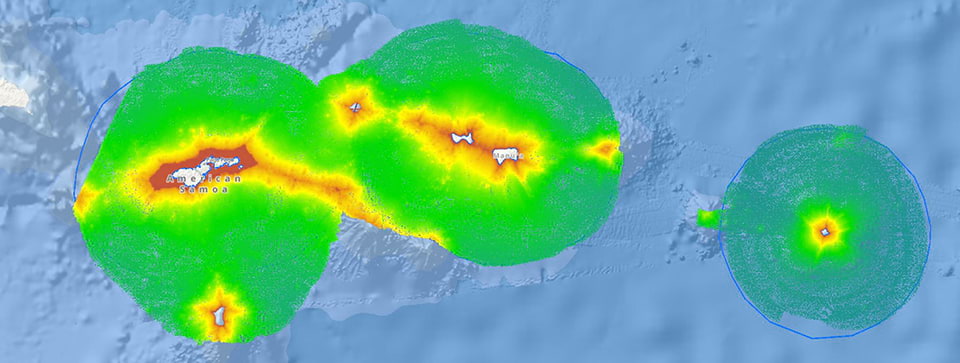Exploring the Pacific on NOAA Ship Rainier
[ad_1]
Why study the Pacific?
The Pacific is the largest and deepest ocean basin on Earth. Many of the islands in its waters – including Guam and American Samoa – sit within or near the Ring of Fire, an area of the Pacific known for earthquakes, tsunamis, and volcanoes. In fact, some Pacific islands and atolls were formed by volcanoes.
Seamounts, extinct volcanoes that rise sharply from the seafloor but remain below the water’s surface, are more common in the Pacific than elsewhere in the ocean. Uncharted seamounts pose a hazard to ships and submarines. Scientists describe seamounts as “oases of life” because so many species live on them.
The Pacific islands, reefs, and atolls are rich in coral biodiversity: there are twice as many coral species there than in the Atlantic. Most corals live in semitropical and tropical waters between the latitudes of 30° north and 30° south of the equator. The shallow reef-building corals are restricted in where they can live by temperature, salinity, and light levels; they need their environments to be warm, salty, and light-filled.
So why did the RICHARD missions go specifically to Guam, the Commonwealth of the Northern Mariana Islands, and even more remote locations like Taʻū Island in American Samoa and Palmyra Atoll in the Northern Line Islands? What all these places have in common is that they are within the U.S.’s exclusive economic zone (EEZ), areas of the ocean where the U.S.has jurisdiction over marine resources.
In the EEZ, the government works to manage things like fish stocks, minerals, and ecologically important habitats, including reefs and marine sanctuaries. To do any of this work effectively and to keep navigation safe, it is necessary to survey the seafloor in the EEZs.
The RICHARD hydrographers’ first objective was to collect high-resolution bathymetric data that would tell them how deep the water was and also discover formations on the seafloor. Such basic data previously did not exist for some of the islands the hydrographers surveyed, and some of the seafloor information they did have was more than 80 years old.
This graphic shows bathymetric information collected around American Samoa, Ofu and Olosega Islands, Taʻū Island, and Rose Island during the 2023 survey season. Land is shown in white; the shallowest water is indicated in red. As the water gets deeper, the colors progress through orange, yellow, green, and blue. (Credit: NOAA)
The Office of Coast Survey will use the hydrographic data collected on the RICHARD missions to update and improve nautical charts for the region. Captains of cruise ships, tankers, and sailboats and other mariners using the charts will be able to navigate around the islands without hitting reefs, seamounts, wreckage from World War II, and other hazards, thereby protecting their vessels and marine habitats.
The bathymetric data collected by hydrographers is considered foundational data because it is information required for many kinds of projects and applications. The foundational data gathered during the RICHARD missions, for instance, might someday be useful to modelers who predict tsunamis or to researchers who study the impact of sea level rise on Pacific islands. The hydrographic data has already proved itself useful to the RICHARD’s marine biologists studying the region’s shallow-reef coral communities. The data has helped the biologists better understand and visualize the habitats of benthic (bottom-dwelling) organisms like corals.
What do scientists look for on coral reefs?
NOAA scientists visit certain Pacific reefs every three years or so to monitor their health over time as part of the National Coral Reef Monitoring Program. (In 2022 and 2023, these reef studies were part of the larger RICHARD missions.) Periodic monitoring lets the scientists know how resilient a reef might be to the effects of human activity and to climate change.
The coral specialists studied corals that live as far down as 30 meters (approximately 98 feet) below the water’s surface and form reefs near islands. These reefs provide habitat for fish and other marine life, and they buffer islands from storm impacts. Some reefs were in populated areas where fishing occurs and that are also tourist destinations. Other reefs were in places where there are few inhabitants, and visitors are rare. It is these far-distant reefs that give scientists a benchmark for what healthy reefs that have experienced few human impacts should look like.
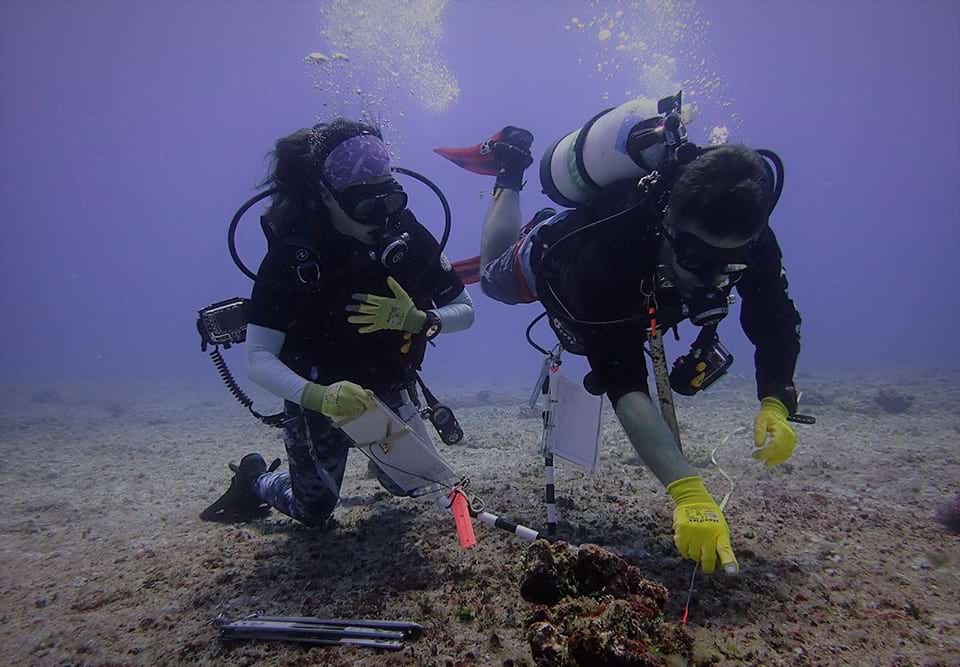
Divers can discuss coral taxonomy underwater by writing on slates and using a special paper that doesn’t tear when it is wet. (Credit: NOAA Fisheries)
Wherever they visited, the scientists counted the numbers and species of corals and checked whether they had diseases, and they looked for “weedy” algal species that can grow quickly and outcompete the more desirable coral species.
The biologists also measured benthic cover, or how much of the seafloor was covered by corals, and they assessed rugosity — that’s how lumpy, bumpy, and wrinkly the corals are. The more dimensionality the corals have, the more complex and healthy the reef will be. All those crevices increase the number of places for fish and other animals to live.
Information about fish numbers and sizes was also collected because this data helps determine how many fish can be caught in an area without depleting stocks. For many island dwellers, the fish in their local waters are their major protein source, so good management is necessary to maintain their food supply. NOAA provides the data gathered by its scientists to the island communities under U.S. jurisdiction so that local resource managers can make informed decisions about their fish resources.
The National Coral Reef Monitoring Program is keeping a close watch to learn how climate change is affecting Pacific corals. They are seeing an increase in coral bleaching, which happens when ocean water warms. However, the cycle of bleaching and recovery for Pacific corals is difficult to determine because the Pacific is so vast, and the islands are remote, making them hard to get to outside the three-year research cycle. While they are away, NOAA scientists rely on satellite data to identify potential “hot spots” in the Pacific, and they collaborate with local island managers to get information about bleaching and recovery events.
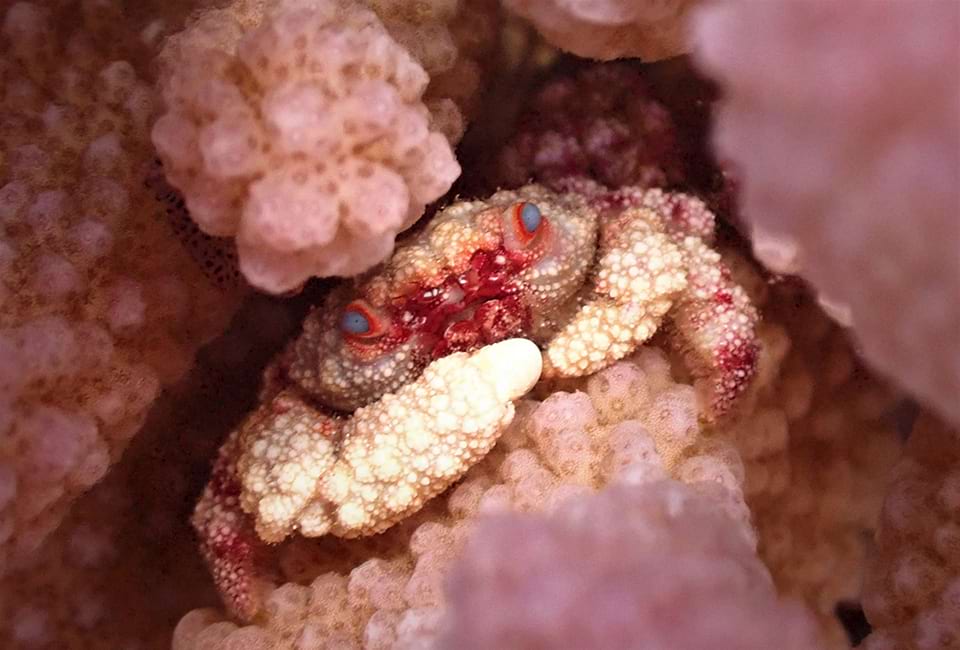
A blue-eyed coral crab, Cymo quadrilobatus, is camouflaged within the branches of an antler coral, Pocillopora grandis. Stony corals provide crabs, fish, and other animals with food and shelter. (Credit: D. Torres-Pulliza/NOAA Fisheries)
To better understand what might be happening between visits, the researchers also leave temperature sensors on the reefs. The sensors let the scientists know when temperature increases occurred, which helps them deduce whether bleaching also might have occurred when they were not there to see it.
Like canaries in a coal mine, corals are a bellwether. When they thrive, the whole reef thrives. As ocean conditions continue to change, coral researchers wonder how easily coral larvae will be able to migrate, settle in different parts of the ocean, and establish new reefs in waters with suitable temperatures. They want to understand any factors that give corals resiliency and a chance to survive — and even thrive — in the face of threats.
How do researchers gather data?
During the two RICHARD missions, NOAA Ship Rainier carried a tremendous amount of equipment to help the research teams gather their data. The marine biologists needed scuba gear and small boats for the thousands of dives they did. They carried underwater cameras and took thousands of pictures that were pieced together to create their 3D habitat models of the reefs. They also used instruments to measure coral rugosity, and others that measured variables such as salinity, temperature, and acidity.
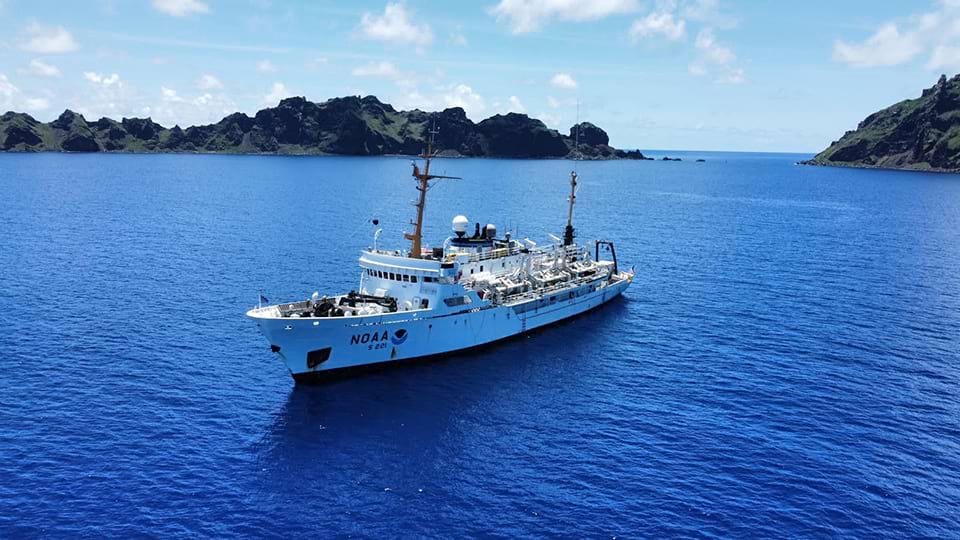
NOAA Ship Rainier within Maug Atoll in the Marianas archipelago. (Credit: OMAO/NOAA)
Increases in atmospheric carbon dioxide makes the ocean more acidic, which in turn decreases levels of chemicals called carbonates in the water. Corals need carbonates in order to take up the calcium they need to form their skeletons, so the researchers also installed equipment on the reef to monitor changes in carbonate chemistry.
The hydrographers used a variety of tools to study the seafloor, but much of their data was gathered using the Rainier’s advanced multibeam sonar system, which is attached to the bottom of the ship and mounted on the ship’s small boats. Multibeam sonar works by sending out multiple, simultaneous sound waves in a fan-shaped pattern (the swath) as the ship moves through the water. When the sound waves hit something — the seafloor, for instance — the sound waves bounce back up. Because hydrographers know how fast sound waves travel to the bottom and return back, they can determine the distance to the seafloor.
However, the RICHARD hydrographers did not just sail along letting sonar do all the work. The scientists had to remain vigilant to maintain data quality. They monitored changes in water temperature, salinity, and pressure, and they had to pay attention to bubbles in the water. These variables affect how sound travels through water. If the scientists did not account for these variables, the sonar data they collected would have been interpreted incorrectly, resulting in inaccurate seafloor maps.
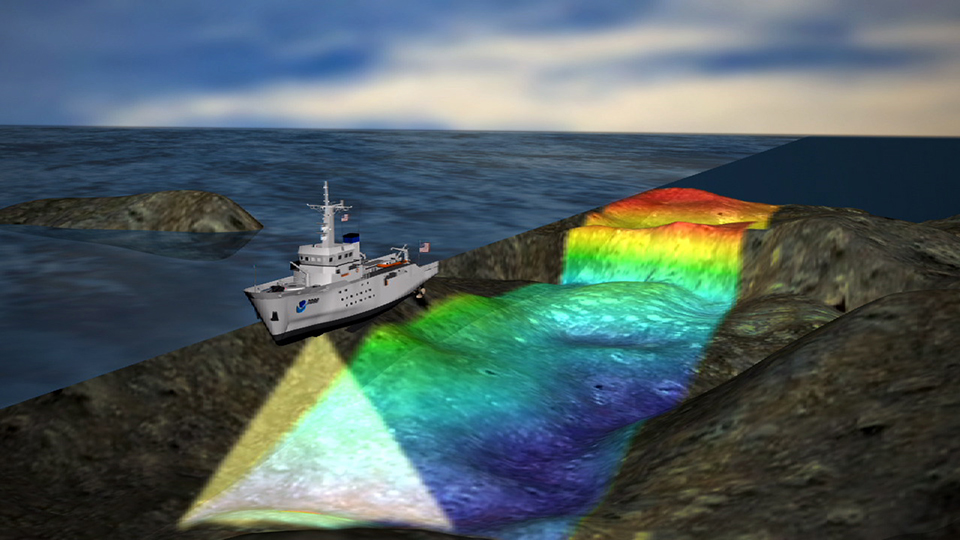
This graphic shows a NOAA survey vessel using multibeam sonar to scan the ocean floor. Collecting hydrography data is time-consuming work, but it is faster to do it in deep water than in shallow water. Hydrographers estimate that the swath produced by multibeam sonar is approximately three times the water’s depth, so the swath is larger in deep water than shallow water. In water 4,000 meters deep, it takes less than a minute to survey a square nautical mile. In water 30 meters deep, it takes about six hours to survey a square nautical mile. (Credit: NOAA)
In shallower waters where the Rainier could not safely go, the hydrographers went out in small boats equipped with the same multibeam sonar technology as the ship. They received an assist from colleagues in NOAA’s National Geodetic Survey, who used lidar to survey shallower water near the coastlines of some islands. This remote sensing technology can be used to study the seafloor from the air, and it’s a safer way to gather data than working in small boats in rough seas.
As they gathered depth data, the hydrographers also collected sonar backscatter data. This data measures the intensity of sounds coming back from the seafloor. The differences in intensity tell the scientists how much sound was absorbed by the seabed, which can indicate the composition of the seabed they are surveying. For instance, hard seafloors like rock, sand, and coral produce high intensity sonar returns; soft seafloors like mud and silt produce lower intensity returns. This is especially useful information when figuring out what parts of the seafloor might provide habitat for living things.
When the RICHARD hydrographers combined bathymetry (depth and shape) data and backscatter data, they were able to produce highly detailed 3D maps of the seafloor at a large scale. These will be linked to the small-scale coral 3D models and fish observations to develop detailed habitat maps showing where these organisms like to live.
Do you want to go to sea with NOAA?
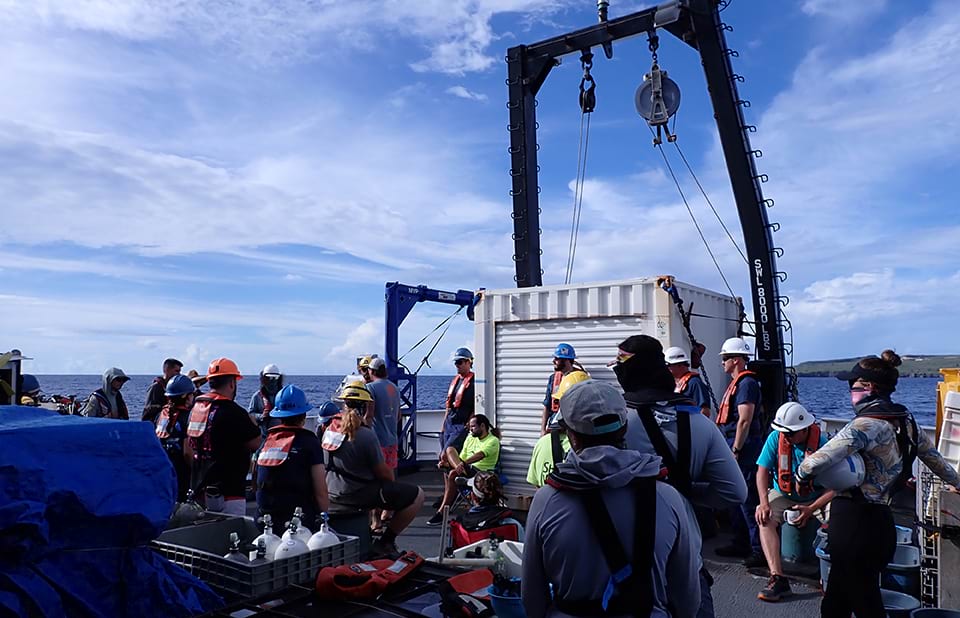
During the RICHARD missions, scientists and crew members gathered every morning on the Rainier’s fantail to discuss the day’s boating and diving operations. (Credit: NOAA Fisheries)
If the RICHARD missions have inspired you to consider a career aboard a NOAA ship, here are a few things to know.
It helps to have training in the sciences. Hydrographers, for example, have to understand physics and statistics. But you do not have to have a hydrography degree to join NOAA’s hydrography team. Because there are so few schools in the United States that teach hydrography, most NOAA hydrographers start with a degree in science, engineering, or math, and they learn on the job and get their training through the Office of Coast Survey.
Coral researchers aboard the Rainier studied the life sciences and have undergraduate and graduate degrees in marine biology, and they know how to scuba dive, do underwater photography, and handle small boats.
NOAA hydrographers and scientists rely on the NOAA fleet to take them to sea and support research activities. NOAA’s ships are operated by a combination of uniformed NOAA Corps officers and civilian professional mariners. Many of these positions do not require a college degree!
Ship commanders, crew, and researchers say that science at sea can be less comfortable than life ashore, so it helps to be adventurous, adaptable, and have a good sense of humor. Prior experience on boats, large and small, also can be helpful, but it is not required. Being meticulous, detail-oriented, patient, and curious and having an insatiable drive to innovate are also good traits to have, if you want to do research. Almost everyone will experience seasickness at some point, but most people recover quickly, and medication can help.
The payoff for the challenges is being part of a close-knit shipboard community that shares in the excitement of making discoveries. Going to sea with NOAA gives you a chance to visit new places, try things you have never tried, and make a difference.
To learn more about research and other career tracks at NOAA, visit the National Ocean Service’s career profiles page, the NOAA Corps site, and the NOAA Office of Marine and Aviation Operations site. NOAA also offers internships for students at every level. Details are available on the student opportunities database.
[ad_2]


